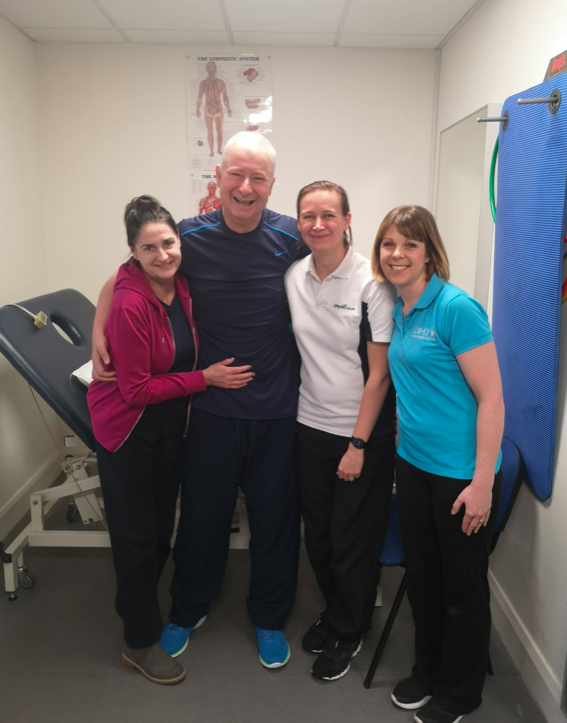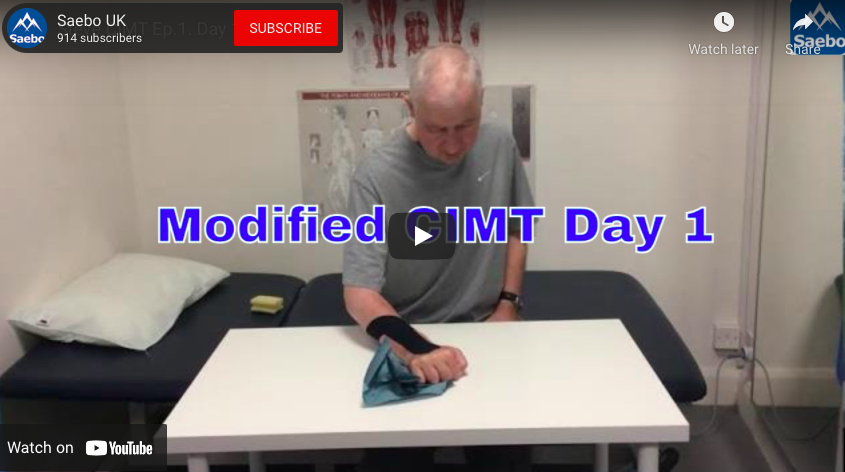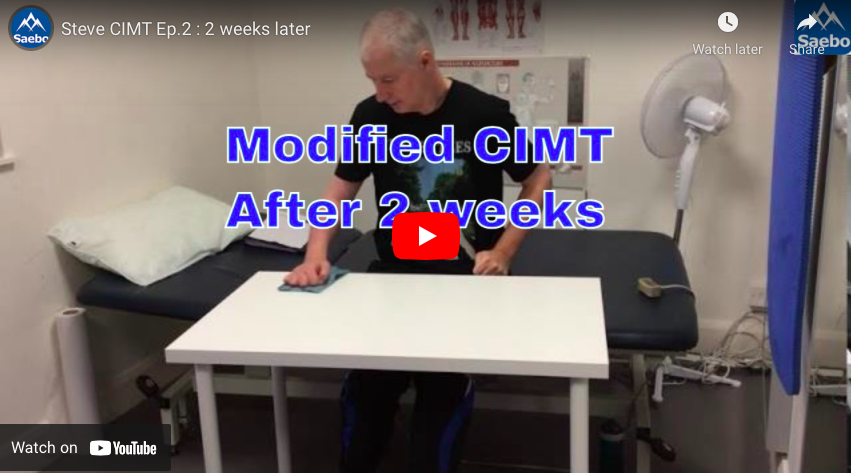Expanding CIMT (Constraint Induced Movement Therapy)
Amy Bean
Wednesday, September 16th, 2020

Guest blog written by Karen Leslie, Senior Neurological Physiotherapist at physio.co.uk

Constraint Induced Movement Therapy (“CIMT”) is an intensive course of rehabilitation for the arm and hand that is effective at improving the use of a weaker side following stroke. The programme is suitable for people with some movement present at the wrist and fingers, enough to crudely grasp a rag and let it go. Hand function is required because the therapy involves wearing a restrictive mitt on the unaffected hand for 90% of waking hours. If there is no ability to use the hand then this would completely disable the person and be of no benefit at all.
But what about people who cannot open their hands? Over the last few years researchers have been investigating whether “expanded CIMT” or “eCIMT” would be suitable for patients whose hands do not have enough movement to qualify for a CIMT programme.
An eCIMT programme involves the same intensity of treatment but without a constraint mitt. The principles of CIMT remain the same, looking at real-world use of the arm and practising specific tasks in an intensive repetitive manner, but the therapy sessions may use adjuncts such as orthotics or electrical stimulation to help position the hand to achieve a greater variety of tasks, and hands-on therapy to help manage muscle tone and body positioning. The primary outcome of any programme should be an increase in how much the person can use their arm in everyday life.
Case study – Steve
Steve suffered a major stroke in 2014 resulting in right sided weakness. His initial outlook for recovery was very poor. It took 14 months for him to relearn to walk with a stick, but he suffered with extreme pain and spasms in his right arm and hand, and it wasn’t until 2019 that he began to develop the ability to move his shoulder and elbow, although he could not use the arm in any activity.
Steve did not meet the criteria for CIMT because he was unable to open his hand, so we recommended a 3 week eCIMT programme. Steve took part in 3 hour therapy sessions for 15 consecutive weekdays.
Therapy sessions involved:
- Intensive repetitive task practise
- Soft tissue mobilisation and sensory stimulation
- The use of adjuncts to expand available movement, eg electrical stimulation, Saebo products (SaeboReach and SaeboGlove), positional taping
- Functional task practise
- Home exercise programme
We worked on his ability to “prop” through his weaker arm, and once we achieved this we were able to explore tasks like holding down items, for example keeping bread still while buttering.
We looked at using his hand to hold items like a toothbrush while he applied paste, meaning he could do this task without help. We also looked at how his arm could be used to wipe down tables, or assist in cleaning and drying himself.
By the end of 3 weeks Steve had improved activity in his shoulder and elbow, with less compensatory movement in his body. He was able to use his right arm to wipe down a table, stabilise items during meal preparation, assist with carrying an object e.g. basket/clothing and use it in bilateral tasks such as washing/drying dishes.
The aim of the programme was to enable Steve to use his arm in day to day life, which would mean he would naturally continue to make improvements because he was moving his arm regularly. Steve’s biggest goal is a “two-armed hug” with his partner, which he is close to achieving. He has continued to work on exercises for his arm and just recently he was able to hold his partner’s hand while walking together.

You can see more of Steve’s story on Twitter with #SteveCIMT or find out more about our CIMT and eCIMT programmes at cimt.co.uk
References:
Taub, E. T., Uswatte, U., Bowman, M., Mark, V. W., Delgado, A., Bryson, C., Morris, D., Bishop-McKay, S. (2013) Constraint-Induced Therapy Combined with Conventional Neurorehabilitation Techniques in Chronic Stroke Patients with Plegic Hands: A Case Series, Arch Phys Med Rehabilitation; 94(1): 86–94.
Taub et al (2018) Rehabilitation of Stroke Patients with Plegic Hands: Randomized Controlled Trial of Expanded Constraint-Induced Movement Therapy, Restor Neurol Neurosci. 2018;36(2):225-244

